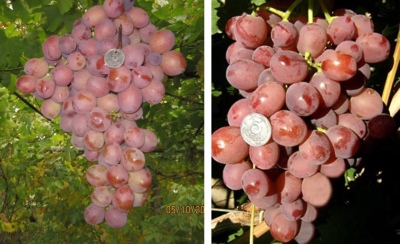
- Authors: Kitaichenko Alexander Ivanovich
- Appointment: dining room
- Berry color: dark pink, with a lilac shade
- Taste: harmonious
- Ripening period: early middle
- Ripening period, days: 115-125
- Frost resistance, ° C: -23
- Bunch weight, g: 500-2000
- Flower type: functionally female
- Skin: dense
Hybrid grape varieties are by far the most popular. And this is not surprising, because such varieties are not too whimsical to care for, withstand severe frosts, and are resistant to many diseases. One of these varieties is the Dozen.
Breeding history
A dozen were bred by the Ukrainian breeder Alexander Ivanovich Kitaychenko in 2007. Grapes appeared when crossing varieties ZOS-1 (Red Delight) and Rizamat + SP (pollen mixture).
Description
Dozens of mature bushes reach a height of 4 meters. These are vigorous plants with powerful roots and shoots. All cuttings take root well. The variety begins to bear fruit for 2-3 years. The foliage is a standard shade, green, serrated.
Ripening period
A dozen are early middle grape varieties. The culture ripens in 115-125 days. In central Russia, the harvest begins in the second half of August.
Bunches
The Dozen's clusters are large, cylindrical in shape and of medium density. On each vine, from 3 to 4 clusters of grapes are formed. Each weighs from 500 grams to 2 kg.
Berries
The berries of this variety are dark pink, with a slight lilac tint. The fruits are large in size, and each weighs from 16 to 18 grams. The wax coating is quite dense, like the skin. The berries are oval in shape, sometimes they can be flattened. The flesh of the Dozen is medium-dense, crispy.
Taste
Experts rated the taste as harmonious. Differs in honey-floral notes, nutmeg is not felt. It is worth noting that this taste can be achieved only when Dozen are grown in sunny areas.
Yield
A dozen are high-yielding varieties. In one season, you can collect up to 100 kilograms of berries from a bush, although this is not an extreme indicator. As already mentioned, grapes begin to bear fruit in 2-3 years, but with improper agricultural technology, the process can take 4-5 years. Harvested berries can be transported, but not far away. Due to the weak attachment of the berries to the bunch, the transportability of this variety is low.


Growing features
When purchasing seedlings from the nursery, make sure they have a branched root. The stems should be light brown in color. The site is selected as sunny as possible, without the slightest shade. Wind and groundwater lying close to the surface are unacceptable. The soil should be chosen loose, for example, loam, black earth, sandy loam soil is well suited. When planting seedlings, they immediately think over the supports. The grapes grow rapidly, their clusters are heavy, and normalization is mandatory here. No more than 2 bunches should be left on each vine.
Landing
Dozen seedlings are planted in early fall or spring when the danger of frost is over. Before this, the site is cleaned and dug up. The pits should be 80 centimeters in diameter and the same depth. The distance between the holes themselves is at least 2 meters. And also a 20-centimeter drainage must be laid at the bottom of the hole, and on top of it is earth with fertilizers (organic matter, superphosphate, wood ash, potassium sulfate). After planting, the root collar should be covered with earth. Each bush is watered with 20 liters of water, mulch after a couple of days.

Pollination
A dozen grapes contain female flowers, nevertheless, pollination is stable, peas are not observed.
Pruning
This procedure is necessary for the Dozen, since the grapes grow rather quickly. Autumn pruning should be annual, with each branch needing to be shortened by 6-8 eyes. Spring pruning is called sanitary: dead and frozen specimens of shoots and branches must be removed. In the summer, stepchildren simply cut off.
In addition, before or after flowering, the bush must be normalized:
vegetative shoots are cut, leaving no more than 24 copies per 6 square meters;
some of the inflorescences are removed, and only 1 bunch is left on the shoots.



Frost resistance and the need for shelter
The variety can withstand frosts down to -23 degrees. However, in the first year, the plants must be covered. The grapes are covered with a film, a large container (pan, bucket) is placed on top, then covered with soil. Adult specimens are not covered, but the winter should be snowy and not cold.
Shelter is a must in cold regions. They use film, agrofibre and other materials. The vines are bent to the ground, fastened with staples, they are thrown over with spruce branches and covered with material.

Diseases and pests
The variety is susceptible to the influence of diseases and pests. Resistance to mildew, powdery mildew and gray rot is low. However, such grapes are practically not affected by wasps. Avoiding disease requires preventive measures and proper care.

If a grape is exposed to any disease or insect, this always affects its appearance.
Storage
The harvested Dozen berries can lie quietly for several weeks without decaying or cracking. Store them in a cool and well-ventilated place.











































































